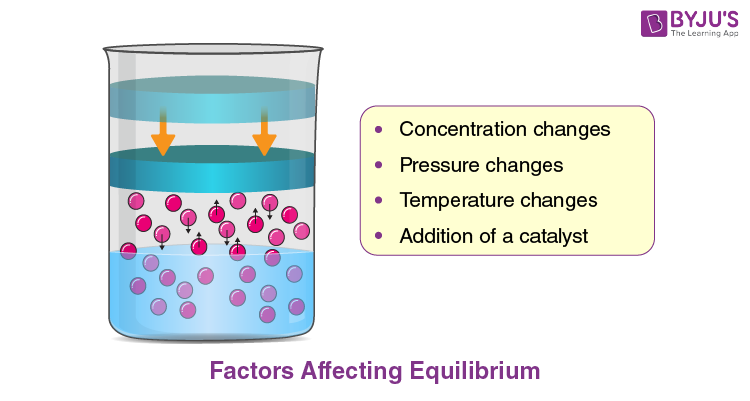In an intricate dance of molecules, the concept of chemical equilibrium reveals itself as both a fundamental principle and a perplexing phenomenon in the realm of chemistry. At first glance, it may seem straightforward. After all, equilibrium denotes a state of balance, right? But herein lies the catch—there are specific conditions under which the expected shifts in equilibrium do not occur. Understanding these nuances can revolutionize our perspective, offering insights into the subtleties that govern the behaviors of chemical systems. Let’s embark on an exploration of the conditions that could stymie a shift in equilibrium, refining our understanding of this captivating subject.
The Dynamics of Chemical Equilibrium
To navigate the complexities of equilibrium, let’s revisit the foundational definitions. Chemical equilibrium involves a state when the rate of the forward reaction equals the rate of the reverse reaction. In such a state, the concentrations of reactants and products remain constant over time. However, when external conditions change, one might expect a shift in this state, often predicted by Le Chatelier’s principle. The principle asserts that a system at equilibrium will adjust to counteract the effects of a disturbance, thereby establishing a new equilibrium. But what happens when this expected response falters?
1. Temperature: The Temperature Trap
Temperature alterations serve as significant levers in shifting equilibrium positions. In exothermic reactions, increasing temperature can favor the reactants, while in endothermic processes, a rise typically shifts equilibrium toward the products. However, one may encounter scenarios where temperature changes yield negligible effects on reaction rates or equilibrium concentrations. Why is this so? One potential culprit is the presence of complex mechanisms or concurrent reactions, which can obscure the straightforward behavior anticipated. Furthermore, when external temperatures are introduced slowly or in a limited range, the system may not have the kinetic energy required to instigate a perceptible shift. Detecting such delicate balances requires acute observational skills and a broader understanding of thermodynamic properties.
2. Pressure: The Pressure Paradox
Similarly, altering pressure primarily affects gaseous reactions, particularly those involving differing numbers of moles of reactants and products. However, in instances where the changes in gaseous states do not manifest as anticipated—perhaps due to the presence of inert gases or when the reaction involves condensed phases (solids and liquids)—the potential for shifts diminishes. A rise in pressure may not create the expected push towards fewer moles of gas if the equilibrium already exists within similar molar quantities. Understanding the physical state of reactants and products is vital; they play a crucial role in establishing whether pressure changes yield tangible outcomes.
3. Concentration: The Concentration Conundrum
Adjustments in the concentrations of either the reactants or products commonly lead to shifts in equilibrium, echoing the logic of Le Chatelier’s principle. Yet, there are instances when modifying concentration fails to elicit the desired response. In reactions involving highly soluble species, for example, adding more reactants might initially seem logical, but this excess can saturate the solvent, ultimately hindering reaction dynamics. Moreover, in systems where reactants have an inherent tendency to favor a particular direction due to kinetic factors, such adjustments might not result in a shift, revealing a more complex interplay between concentration and reaction rates.
4. Catalysts: The Catalyst Conundrum
Catalysts play a pivotal role in enhancing reaction rates; their addition can dramatically alter the speed at which equilibrium is attained. However, one must remember that although a catalyst will expedite the rate of both the forward and reverse reactions equally, it does not shift the position of equilibrium itself. Consequently, relying solely on catalysts for a perceived shift may lead to disappointment when equilibrium remains unchanged. This highlights the importance of comprehensive strategies that consider the multifaceted nature of chemical reactions.
5. Reaction Quotient: The Equation of Failure
In the pursuit of understanding equilibrium shifts, the reaction quotient (Q) emerges as a crucial player. It offers insight into the current state of the reaction in relation to its equilibrium condition. Should Q equal the equilibrium constant (K), the system remains balanced, and alterations may yield little more than transient effects. However, when Q deviates significantly from K, the anticipation for a shift is ripe. Yet, if intrinsic factors such as temperature, phase behavior, or concentration ratios create a negative feedback loop, the hope for a shift may dissolve. This nuanced interplay underscores the need for careful calculations and evaluations when predicting the behavior of chemical systems.
6. External Influences: The Environmental Factor
Finally, external environmental influences such as light, electromagnetic fields, and the presence of other chemical species may inadvertently impact equilibrium states. Photochemical reactions could obscure expected shifts, just as the presence of complex ions in solution could mask the behavior of reactants and products. Recognizing how these external forces engage with chemical processes can unveil layers of complexity that challenge simplistic notions of equilibrium shifts.
As we delve into the labyrinth of chemical equilibrium, we discover that the parameters dictating reaction behaviors are multifaceted and often unpredictable. The beautiful intricacies of molecules and their interactions invite continuous inquiry, teasing our understanding and expanding our perspective. By unpacking the reasons behind stunted shifts in equilibrium and recognizing the array of influencing factors, we not only enhance our knowledge but also cultivate a deeper appreciation for the dynamic world of chemistry that surrounds us. Embrace the uncertainty, as it often leads to the most profound revelations.
